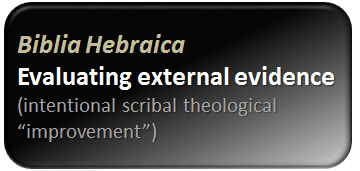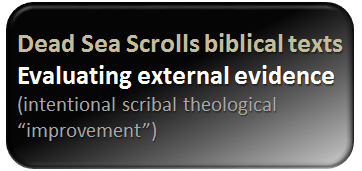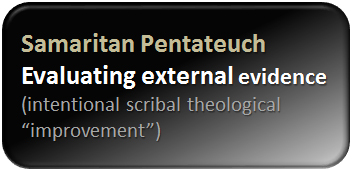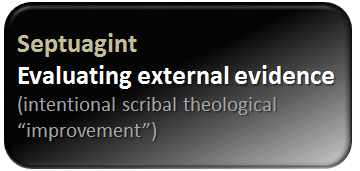 |  |  |  |  |

| Evaluating Internal Evidence Investigating internal evidence means thinking with ancient scribes. We can begin to get at this by reverse engineering variants this way and that based on close attention to scriptural details themselves. Detailed consideration of the scriptural context naturally also improves exegetical outcomes. Evaluate internal evidence (Deut 32:8)
Provisional Decision There are no rules for making responsible text critical
decisions. A couple of general guidelines are often useful. →
Shorter reading is often preferred →
More difficult text is often preferred →
“Which is more likely to have given rise to the other?” (McCarter 1986, 72)
Selected commentaries Academic scriptural
commentaries like Anchor Bible, International Critical Commentary, Old Testament
Library, New International Commentary on the Old Testament, Word The Aramaic
Bible (Collegeville, MN: Michael Glazier). (NET) New
English Translation Bible (Biblical Studies Press, 1996), net.bible.org. NET
provides student-friendly text critical notes on many of the most important
variants. Wevers, John
William. Notes on the Greek Text of Genesis (Atlanta: Scholars Press,
1993). Notes on the Greek Text of Exodus (1993). Notes on the Greek
Text of Leviticus (1997). Notes on the Greek Text of Numbers (1998).
Notes on the Greek Text of Deuteronomy (1995). Wevers’ series of studies
on LXX of Pentateuch offers passage by passage detailed discussion of apparent
and real deviations between MT and LXX and/or explanations of the Greek
translator may have interpreted Vorlage.
Other text critical
helps Emanuel Tov, Textual Criticism of the Hebrew Bible,
3d ed. (Fortress, 1992, 2001, 2012). Vroom, Jonathan.
“A Cognitive Approach to Copying Errors: Haplography and Textual Transmission
of the Hebrew Bible,” Journal for the Study of the Old Testament 40.3
(2016): 259-279. This study explains that many text critical emendations based
on alleged haplography/omissions (whether homoeoteleuton or homoeoarcton) need
to repealed since cognitive psychology has demonstrated reading is based on processing
of entire words not sequential recognition of individual letters. This basic
point is combined with analysis of how “working memory” functions when manually
copying, when scribe turns back toward to place in the Vorlage where the
scribe left off (referred to as “visuospatial sketchpad”); a scribe does not
need to read through entire Vorlage to locate where he left off, but by
use of working short-term memory turns back to the basic location (not a
different column or six inches up or down in the same column) looking not at
individual letters but looking for word(s). Thus, arguing for haplography
requires demonstrating that there is a deceptively similar word(s) in the Vorlage
at approximately the same vertical place in the same column. This effectively
eliminates both arguing for omissions based on repetition of single letters,
and also for arguments of large omissions (contra Lundbom’s extravagant
use of haplography based in a majority of cases on single letters to argue for
LXX as botched derivative, see 275). Vroom’s essay includes visual illustration
and examples. Ernst Würthwein, The Text of the Old Testament: An
Introduction to the Biblia Hebraica. 3d
ed. rev. by Alexanderr Achilles Fischer, trans. Erroll F. Rhodes
(Eerdmans, 2014). See Hebrew BIble Exegesis Reference Works And see other titles at For Further Reading |       |

